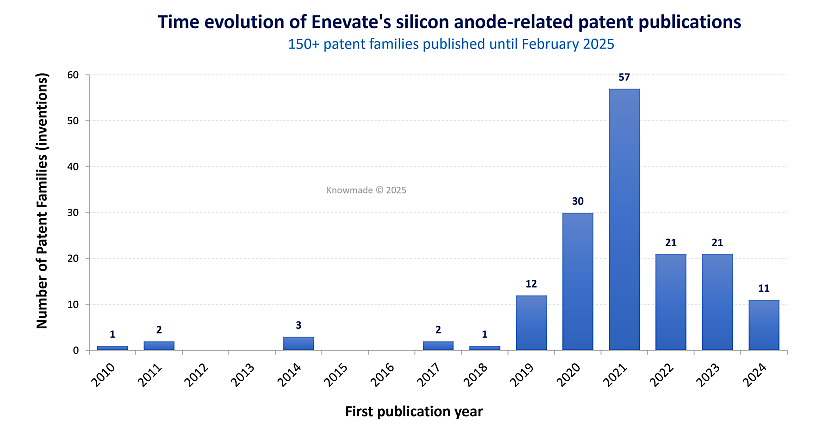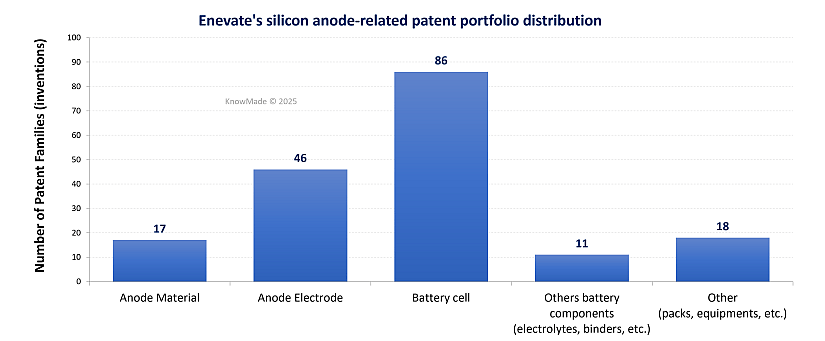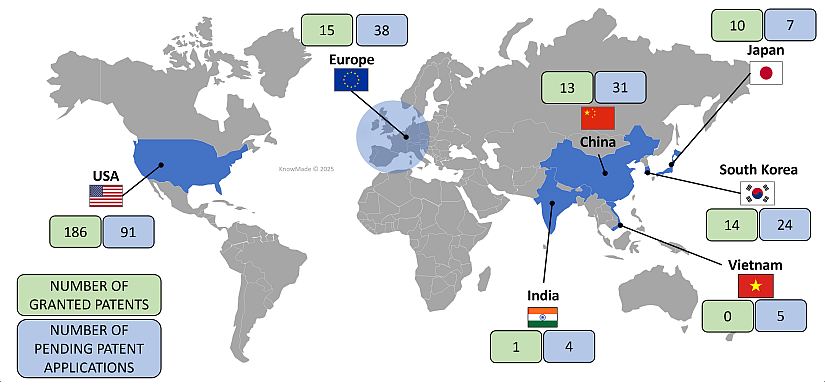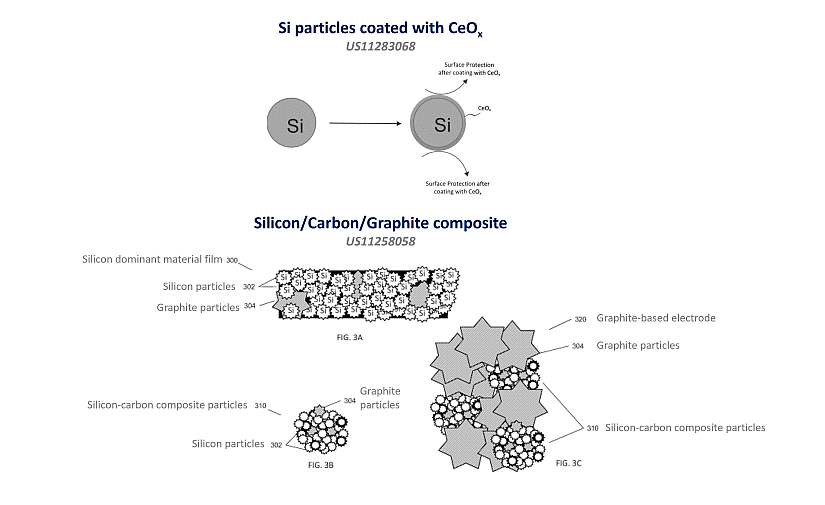SOPHIA ANTIPOLIS, France – April 2, 2025 │The increase in energy density is one of the main drivers for battery technology. On the anode side, silicon is a promising material to replace graphite and enhance battery performance, but several technical challenges exist, slowing the adoption of this technology. R&D laboratories and industrial companies quickly recognized the potentiality of silicon as an anode material for Li-ion batteries, leading to significant investments to bring this technology to market.
In such a highly competitive and dynamic environment, analyzing the patent landscape is essential to understand the technology strategies of key players and their intellectual property (IP) positions. To address this need, KnowMade has released a comprehensive new Silicon Anode Batteries Patent Landscape report. It provides an in-depth analysis of the current IP positions of industry leaders, emerging players, and start-ups, offering valuable insights into their IP strategies and R&D priorities. Given the sharp rise in patent publications in recent years, KnowMade has also launched a dedicated Patent Monitoring Service focused on Silicon Anode Li-ion Batteries. This new service enables clients to closely monitor the latest patent filings and technological trends, identify key industry players and emerging competitors, and stay up to date with cutting-edge innovations in the field of silicon-based lithium-ion battery technologies.
In most of KnowMade’s research, analyzing pure players and start-ups among patent holders is a crucial component. Their patent portfolios reveal the specific technologies they are focusing on and the key market areas they aim to secure.
Enevate: Pioneering a New Generation of Li-ion Batteries Using Silicon-Dominant Anode
Founded in 2005, in Irvine, California, Enevate is a battery pure player that develops and licenses advanced silicon-dominant anode Li-ion battery technology for electric vehicles (EVs), with a vision of charging EVs as fast as refueling gas-powered cars and accelerating their mass adoption. According to BloombergNEF, Enevate has raised $141 million as of September 2024, possibly through private equity, venture capital, and grant funding. In 2021, Enevate announced a new production license agreement with the South-Korean, EnerTech International, to commercialize Enevate’s silicon dominant XFC-EnergyTM battery technology in the transportation, mobility and reserve power markets. In 2022, it declared a partnership with the Italian marine propulsion innovator Sealence to develop high-performance battery cell for marine applications. In 2023, Enevate and the South-Korean JR Energy Solution, revealed their collaboration to build a battery electrode manufacturing facility in the USA. The same year, Enevate and NantG Power announced partnership to combine their proprietary cathode and anode innovations to commercialize and scale up a breakthrough silicon-dominant battery technology in transportation, mobility, and other markets.
Overview of Enevate’s Patent Portfolio in Silicon Anode-Based Li-ion Battery Technology
As of February 2025, Enevate holds over 160 patent families (inventions), with approximately 155 focused on core technologies related to silicon anode Li-ion batteries. The remaining patents cover more general innovations, such as apparatuses for processing battery electrodes or methods for manufacturing battery separators, etc.
The evolution of patent filings reflects the different phases of Enevate’s development, strategic partnerships, and commercialization. As shown in Figure 1, Enevate’s patent activity was minimal during the 2010–2018 period, likely corresponding to early R&D and proof-of-concept work (a phase focused on laying the technological foundation, with internal development and limited IP disclosure). The dramatic increase from 2019 to 2021 reflects a major ramp-up in innovation, likely tied to product readiness, commercial partnerships, and funding rounds. This strong surge positioned Enevate among the most active and prominent IP players in the silicon anode battery domain, strategically strengthening its IP position in anticipation of market entry or licensing activities.
The stabilized patent activity over the past three years may indicate that the core technology has matured, reducing the need for foundational patents and shifting focus toward incremental improvements and application-specific innovations. Enevate has built a sizable and sustained IP presence in silicon anode technologies, and the consistency of filings even after the peak year reflects ongoing investment and a long-term commitment to maintaining technological leadership.

Figure 1: Time evolution of Enevate’s patent publications related to silicon anode Li-ion batteries.
The distribution of Enevate’s patent portfolio (Figure 2) reflects a well-balanced and coherent innovation strategy. Enevate’s largest patent category is related to the battery cell (86 patent families), highlighting its core technological focus on optimizing cell architecture. This aligns with the company’s flagship XFC-Energy™ technology, which emphasizes ultra-fast charging and high energy density at the cell level. A large portion of patents covers innovations in the anode electrode segment (46 patent families), which is critical for enabling fast charge and long cycle life in silicon-based batteries. This supports Enevate’s differentiation around its proprietary silicon-dominant anode technology. While smaller in number, the 17 patent families related to anode material indicate focused R&D on materials engineering to address technical challenges of silicon anodes such as volume expansion, cycling stability, and electrochemical performance. These innovations are foundational to the company’s core technology. In parallel, Enevate has also secured patents related to other battery components (electrolytes, binders, etc.) and system-level aspects (battery pack, equipment), reflecting Enevate’s attention to manufacturability and integration. Altogether, this alignment between patent portfolio, technological development, and business strategy strengthens Enevate’s positioning as a credible and leading innovator in the field of silicon anode Li-ion batteries.

Figure 2: Enevate’s silicon anode-related patent portfolio by core invention type. Note that a patent family can belong to multiple segments.
Enevate’s Worldwide IP Coverage Reflects a Global Vision for Silicon Anode Technology
Enevate has implemented a truly global IP strategy to protect its silicon anode-related inventions (Figure 3). The U.S. remains its main territory, with a very strong presence: 186 granted patents and 91 pending applications, reflecting both Enevate’s domestic R&D base and the importance of the U.S. market for EV technologies.
In Europe, China, and South Korea, the company has also built a significant IP portfolio, particularly around anode material innovations. These three regions concentrate most of Enevate’s foreign patent filings, indicating they are key strategic markets or manufacturing hubs the company is aiming to penetrate or influence through licensing. The company has partnerships or interest from large battery and automotive players (e.g., LG Chem, Samsung SDI, Renault–Nissan–Mitsubishi) based in these regions, aligning with its patenting efforts.
More recent filings in India and Vietnam show that Enevate is gradually extending its territorial coverage. In India, patent applications are primarily related to battery cells, while Vietnam appears to be a newer target with pending applications only. This suggests proactive protection ahead of potential licensing, supply chain integration, or manufacturing partnerships. It indicates forward planning in regions with growing roles in battery production.
Overall, Enevate’s geographic IP coverage aligns with both market relevance and supply chain considerations. The company appears to focus its efforts on jurisdictions with high commercial potential and/or strong battery production infrastructures. The combination of mature patent portfolios in established regions and growing activity in emerging markets reinforces Enevate’s positioning as a forward-looking player with ambitions for global commercialization.

Figure 3: Geographical coverage of Enevate’s silicon anode-related patent portfolio
Enevate’s Recent IP Developments Related to Silicon-Based Anode Materials
Enevate’s patent portfolio related to silicon-based anode materials for lithium-ion batteries specifically addresses the core challenge of silicon’s significant volume expansion during cycling, which leads to mechanical failure and reduced cycle life. These inventions mainly center on composite materials that can integrate high-loading silicon particles with carbon-based networks, along with surface coatings (such as silicon carbide, metal oxides, etc.) to notably enhance structural integrity, electrical conductivity, and SEI stability.
Over the last years, Enevate has expanded its patent portfolio with several innovations targeting silicon-based anode materials. The following recent patent filings illustrate the company’s main technological approaches to overcoming the challenges of silicon anodes.
- The patent application US20240136506 addresses key technical challenges in lithium-ion battery performance, notably the limited lifetime, low initial coulombic efficiency (ICE), and high resistivity often associated with silicon-based anodes. To overcome these issues, the inventors propose an innovative electrode design comprising a plurality of elemental silicon particles, each coated with a carbon-based layer. This coating enhances electrical conductivity and structural stability, mitigating the mechanical degradation caused by silicon’s volume expansion during charge-discharge cycles. The main claim centers on an electrode where each silicon particle is individually coated, forming a composite active material. This configuration aims to improve ICE (exceeding 90.5%) and reduce resistivity (below 1), offering a more efficient and durable solution for next-generation lithium-ion batteries.
- The patent US11283068 addresses the critical limitations of silicon-based anodes in lithium-ion batteries, such as severe volume expansion, structural degradation, and solid electrolyte interphase (SEI) instability, which collectively reduce battery performance and cycle life. To overcome these challenges, the inventors propose an innovative method for preparing electrochemically active materials by coating silicon-based particles with a conformal layer of cerium oxide. This coating is achieved through a controlled process involving binder-assisted deposition of a metal salt precursor followed by thermal conversion to a uniform cerium oxide layer, notably free from aggregates. The conformal cerium oxide layer improves chemical and mechanical stability of the electrochemically active material, especially under the stress of battery cycling. By avoiding cerium oxide aggregates, the method ensures uniform coverage and prevents defects that could degrade battery performance. The use of specific surfactants in the binder (e.g. sodium dodecylsulfonate, sodium dodecylbenzenesulfonate, etc.) enhances the dispersion and coating process, contributing to more consistent and scalable manufacturing. The approach aims to stabilize the electrode structure, minimize degradation reactions, and enhance the long-term performance and manufacturability of high-capacity silicon anodes for next-generation lithium-ion batteries.
- The patent US11258058 addresses several key limitations of conventional silicon-based battery anodes (such as complex manufacturing processes, performance degradation due to silicon’s volume expansion during cycling, etc.). The inventors propose a silicon-carbon composite that could improve electrical conductivity, cycling stability, and manufacturability. The main claim defines a composite powder composed of 75–90% by weight silicon particles (D50 size 0.1–1.0 μm), 5–15% conductive carbon particles (e.g., graphite, also 0.1–1.0 μm), and a pyrolyzed carbon coating derived from a polymer precursor that encapsulates silicon particles. This coating limits direct exposure of silicon to electrolytes, mitigating solid electrolyte interphase (SEI) formation and capacity loss. The entire composite powder has a D50 size distribution between 5–15 μm. It could enable to obtain high-capacity and stable lithium-ion batteries.

Figure 4: Examples of Enevate’s recent patent applications on silicon-based materials
Monitoring Pure-Players and Start-Ups Worldwide
In KnowMade’s Silicon Anode for Li-ion Batteries Patent Landscape report, over 290 start-ups and pure players were identified, most of which are based in China. Analyzing the technologies covered by their patents provides valuable insights into their technological roadmaps, the future products they aim to bring to market, and the competitive risks they may pose.
Throughout the year, KnowMade’s analysts track and analyze the latest patenting activities of competitors involved in developing cutting-edge battery technologies. These include efforts to increase energy density (e.g., silicon anodes, Li-metal anodes, NMC cathodes, anode-less designs), improve safety and longevity (e.g., solid-state batteries, thermal management solutions), reduce costs (e.g., LFP/LMFP cathodes, Na-based batteries), and minimize environmental impact (e.g., battery recycling). By doing so, KnowMade provides a comprehensive view of the IP landscape shaping the future of energy storage technologies.
Press contact
contact@knowmade.fr
Le Drakkar, 2405 route des Dolines, 06560 Valbonne Sophia Antipolis, France
www.knowmade.com
About the author
Arnaud Capgras works for KnowMade as a Patent Analyst in the field of Materials Chemistry and Energy storage. He holds a Chemistry-Process Engineering Degree from the Chemistry and Chemical Engineering School of Lyon (CPE Lyon, France). He also holds the International Industrial Property Studies Diploma (Patents) from the CEIPI (Strasbourg, France).
About KnowMade
KnowMade is a technology intelligence and IP strategy consulting company specialized in analyzing patents and scientific publications. The company helps innovative companies, investors, and R&D organizations to understand competitive landscape, follow technological evolutions, reduce uncertainties, and identify opportunities and risks in terms of technology and intellectual property.
KnowMade’s analysts combine their strong technology expertise and in-depth knowledge of patents with powerful analytics tools and methodologies to turn patent information and scientific literature into actionable insights, providing high added value reports for decision makers working in R&D, innovation strategy, intellectual property, and marketing. Our experts provide prior art search, patent landscape analysis, freedom-to-operate analysis, IP due diligence, and monitoring services.
KnowMade has a solid expertise in Compound Semiconductors, Power Electronics, Batteries, RF Technologies & Wireless Communications, Solid-State Lighting & Display, Photonics, Memories, MEMS & Sensors, Semiconductor Packaging, Medical Devices, Medical Imaging, Microfluidics, Biotechnology, Pharmaceutics, and Agri-Food.
